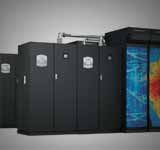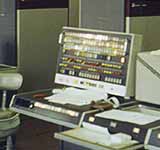Blue Waters is a petascale supercomputer, located in the NCSA (National Center for Supercomputing Applications) at the University of Illinois at Urbana-Champaign. On August 8, 2007, the National Science Board approved a resolution authorizing the National Science Foundation (NSF for its acronym in English, of Nation Science Foundation) of the US to finance the acquisition and development of supercomputers more powerful in his class.
2. CDC STAR-100
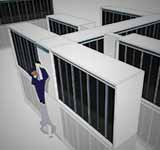
The STAR-100 was a supercomputer produced by Control Data Corporation (CDC) and was the first machine to use vectorial processors to improve performance in mathematical calculation and its power was 1 MIpS and 100mFlOPs. However, some features of the machine negatively affected the real performance, which was much lower than expected. The first commercial installations were carried out in 1974, the CDC was pushed to introduce the machine to maintain its supremacy in the sector of the supercomputer also because after two years the Cray-1 would have been presented even though it sold only 5 units. The STAR was the first CDC machine with 64-bit architecture. Its architecture was not similar to the CDC 6600 or the CDC 7600. It was a machine with a RISC type CPU with the support of several secondary processors that dealt with performing secondary tasks relieving the processor of these tasks and allowing it to perform only arithmetic operations. In the STAR both the CPU and peripheral processors were deliberately simplified to reduce the cost and complexity of the machine.
3. AN/FSQ-7
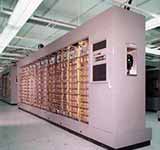
The computer interception AN/FSQ-7, developed by IBM in partnership with the United States Air Force. It was used in the execution of command and control functions for the SAGE air defense system. The AN/FSQ-7 used 55,000 vacuum tubes, occupied a space close to 2,000 m2, weighed 275 tons and consumed up to three megawatts of energy. The AN/FSQ-7 are still the largest computers built, and will probably hold the record in the future. Fifty-two computers were built. The concept was first tested on the Whirlwind I in Cambridge, Massachusetts, and connected to receive data from long-range and several short-range radars installed on Cape Cod. The key breakthrough was the development of magnetic core memory that immensely improved the reliability of the machine, the speed of operation (×2), and the speed of input (×4), on the original memory of the Williams tube of the Whirlwind I.
4. CDC 7600
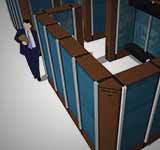
The CDC 7600 was a supercomputer developed by Seymour Cray as a successor to the CDC 6600 and produced by Control Data Corporation. The system allowed the CDC to strengthen its domination in the supercomputer sector for much of the 1970s. It was about 10 times faster than the previous CDC 6600 and was able to develop up to 36 MegaFLOPS with code compiled specifically for the machine. Although the 7600 shared with the 6600 many features such as the instruction size of 60 bits per word the code was not compatible with the CDC 6600. In addition the COMPASS assembler source code it was not compatible, some 7600 instructions were not present on the CDC 6600 and vice versa. What in theory seems simple in practice is often complicated to achieve. To work properly the pipeline must be composed of practically independent functional stages, but this was very difficult to achieve in real applications. However the pipeline provided a performance increase of about three times compared to 6600.
5. Cray-1
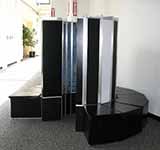
The Cray-1 was the first supercomputer of the company Cray, whose architecture was developed by the team around Seymour Cray. Seymour Cray was responsible for vector register technology. The first Cray-1 was put into operation in 1976 at the Los Alamos National Laboratory. The Los Alamos National Laboratory was awarded in 1976, the first Cray-1 for 8.8 million US dollars (equivalent to a current value of approximately $37.1 million) and used the supercomputer u.a. for nuclear weapon test calculations. The National Center for Atmospheric Research (NCAR) was the first official commercial customer of Cray in July 1977. NCAR paid $8.86 million, including $1 million for storage. This Cray-1 was taken out of service until 1989.
When the first Atlas was put into operation at the University of Manchester in 1962, it was one of the first supercomputers, and the fastest until the release of the CDC 6600.
7. CDC 6600
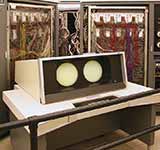
The CDC 6600 was the first supercomputer built by Control Data Corporation in 1963. In general it is considered the first supercomputer with a wide commercial success. It became the fastest supercomputer of its era being three times faster than the previous IBM 7030 Stretch. It remained the most powerful computer on the planet between 1964 and 1969 when it was overtaken by the successor CDC 7600. It was the first system to implement scoreboarding. The organization of the CDC 6600 was used by CDC for the development of the simpler (and slower) CDC 6400 and later for the development of a system based on two CDC 6400 processors which became the CDC 6500. These machines are code compatible with the 6600 but due to the simpler and sequential design they are slower systems. The CDC 7600 successor was initially supposed to be compatible with the 6600 code but later the compatibility is abandoned for better performance.
8. IBM 7030 Stretch
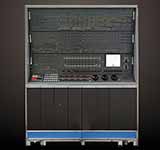
L' IBM 7030, also known as Stretch, was the first supercomputer to transistors produced by IBM. The first 7030 was installed at Los Alamos in 1961. Initially sold for 13.5 million US dollars later the price was reduced to 7.78 million dollars due to the performance not up to expectations and the price with customers who had already purchased the machine was renegotiated. Although the 7030 was much slower than expected however the supercomputer was the fastest machine on the planet between 1961 and 1964, date of presentation of the CDC 6600. IBM activated a small team at Poughkeepsie that included John Griffith and Gene Amdahl to work on developing the new system. When the proposal was now complete and ready for presentation, Ralph Palmer blocked the team by saying "It's a mistake". The proposal was based on contact point transistors or barrier surface transistors but the recently invented diffusion transistors they would have rendered the previous technologies obsolete and therefore also the projects based on them. The team showed Livermore his proposal but said "We do not want to implement this system for you, we want to achieve a much better system". We do not know exactly how much it will cost but we think it will take another million and another year and we do not know how long it will be fast but we hope to reach ten million instructions per second.
9. IBM 7090
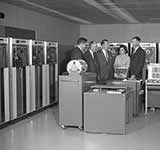
The computer 7090 was created in late 1958 by IBM (International Business Machines). Its predecessor, IBM 709, used vacuum tubes but the IBM 7090 already used transistors, achieving speeds six times higher than its predecessor. And much more difference in speed was observed with the IBM 704 which was less powerful. The first ones installed date from the end of 1959. It was compatible with many of the programs created for 704 and shared part of the instruction set of the 709. The IBM 7090 was created as a general-purpose computer, but, like all computers of its time, its design paid attention to speed in scientific calculation. It was also used for business as stock controller, company accounting, etc. By 1965, more than 300 IBM 7090/94 had been sold, with a price of around three million dollars.
10. UNIVAC LARC
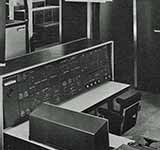
The UNIVAC LARC (Livermore Advanced Research Computer) was Remington Rand's first attempt to build a supercomputer. It was designed for multiprocessor with 2 CPUs (called computers) and a processor dedicated to input/output (called processor). The LARC is a computer with an architecture with 48-bit words. The system used a bi-quinary notation with decimal coding with 4 bits per digit with 11-digit words (negative and positive). The instruction set was 48 bits, each digit of the machine has a parity bit for error checking. In essence, each word occupied 60 bits (48 for data and 12 for parity). The basic configuration includes 26 generic registers that could be expanded up to 99. The system accessed the registers in a microsecond. The basic configuration was equipped with a single computer that could be expanded with a second computer. The processor was an independent CPU (with a different set of instructions than computers) that managed to manage 12 or 24 magnetic drum units, between four and forty UNISERVO II tape drives, two electronic recorders, a high speed printer and a high speed card reader.


